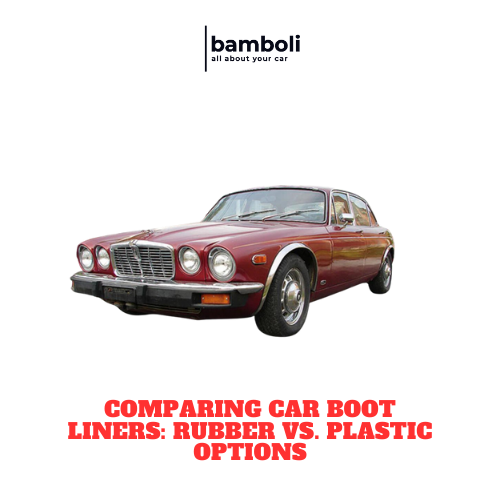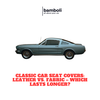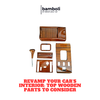Comparing Car Boot Liners: Rubber vs. Plastic Options

Comparing Car Boot Liners: Rubber vs. Plastic Options
Protecting your car’s trunk from spills, dirt, and wear is essential for maintaining its value and cleanliness. Car boot liners are a practical solution, providing a protective barrier between your cargo and the trunk floor. When it comes to choosing a boot liner, rubber and plastic are the two most popular materials. This comprehensive comparison will explore the pros and cons of rubber and plastic boot liners, helping you determine which is best suited for your vehicle.
Understanding Boot Liners
Rubber Boot Liners
Rubber boot liners are known for their durability and flexibility. They are designed to withstand heavy use and provide a non-slip surface that keeps your cargo in place.
Pros:
- Durability: Rubber liners are highly durable and can withstand heavy loads without tearing or wearing out.
- Non-Slip Surface: The rubber material provides a non-slip surface, ensuring that your cargo stays in place during transit.
- Easy to Clean: Rubber liners are easy to clean with water and mild soap, making maintenance straightforward.
- Flexibility: The flexibility of rubber allows it to fit snugly in your trunk, covering every nook and cranny.
Cons:
- Weight: Rubber liners can be heavier than plastic, which might make them slightly more cumbersome to handle.
- Odor: Some rubber liners may emit an odor, especially when new.
Plastic Boot Liners
Plastic boot liners are lightweight and rigid, offering a different set of advantages. They are typically made from high-density polyethylene (HDPE) or similar materials.
Pros:
- Lightweight: Plastic liners are generally lighter than rubber, making them easier to install and remove.
- Rigid Structure: The rigidity of plastic provides a stable surface that is resistant to deformation under heavy loads.
- Waterproof: Plastic liners are fully waterproof, protecting your trunk from liquid spills.
- Variety: Available in various designs and colors, plastic liners can be chosen to match your vehicle’s interior.
Cons:
- Slippery Surface: Plastic can be slippery, causing items to shift during transit.
- Brittleness: In extreme cold, plastic liners can become brittle and may crack.
Detailed Comparison: Rubber vs. Plastic
Protection and Durability
|
Aspect |
Rubber Boot Liners |
Plastic Boot Liners |
|
Durability |
Highly durable and resistant to wear |
Durable but can be brittle in extreme cold |
|
Protection |
Excellent protection against spills and dirt |
Great protection, but can crack under heavy impact |
|
Flexibility |
Flexible and fits snugly |
Rigid and maintains shape |
Rubber boot liners excel in durability and flexibility, making them suitable for heavy-duty use. Plastic liners provide excellent protection but may be prone to cracking under extreme conditions.
Maintenance and Cleaning
|
Aspect |
Rubber Boot Liners |
Plastic Boot Liners |
|
Cleaning Ease |
Easy to clean with water and soap |
Easy to clean, fully waterproof |
|
Stain Resistance |
Resistant to most stains |
Fully resistant to stains |
|
Odor |
May emit an odor when new |
Generally odorless |
Both rubber and plastic liners are easy to clean, but rubber liners may emit an odor, particularly when new.
Real-World Use Cases
Scenario 1: Heavy-Duty Use
For those who frequently transport heavy or rough items, such as tools, sports equipment, or gardening supplies, rubber boot liners are ideal. Their durability and non-slip surface ensure that your trunk remains protected and your cargo stays in place.
Scenario 2: Everyday Use and Aesthetics
For everyday use, where lighter items like groceries or luggage are transported, plastic boot liners offer a lightweight and aesthetically pleasing option. Their rigid structure and variety of designs make them a practical choice for regular use.
Pros and Cons Recap
Rubber Boot Liners
Pros:
- Highly durable and resistant to wear
- Non-slip surface keeps cargo in place
- Easy to clean and maintain
- Flexible and fits snugly
Cons:
- Heavier than plastic
- May emit an odor initially
Plastic Boot Liners
Pros:
- Lightweight and easy to handle
- Rigid structure provides stability
- Fully waterproof
- Available in various designs and colors
Cons:
- Slippery surface can cause cargo to shift
- Can become brittle and crack in extreme cold
Factors to Consider When Choosing
When deciding between rubber and plastic boot liners, consider the following factors:
Usage Frequency
If you frequently use your trunk for transporting heavy or rough items, a rubber boot liner is more durable and offers better protection. For occasional use and lighter cargo, plastic liners are sufficient and easier to handle.
Climate
Consider the climate where you live. In areas with extreme cold, plastic liners may become brittle and crack, making rubber a more reliable choice.
Budget
Rubber liners tend to be more expensive than plastic due to their durability and material quality. If budget is a concern, plastic liners offer a cost-effective alternative without compromising on basic protection.
Installation Tips
Installing Rubber Boot Liners:
- Fit Check: Ensure the liner is the correct size for your trunk.
- Unroll and Lay Flat: Unroll the liner and lay it flat in the trunk, smoothing out any wrinkles.
- Adjust: Adjust the liner to fit snugly around the edges of the trunk.
Installing Plastic Boot Liners:
- Fit Check: Measure your trunk to ensure the liner fits correctly.
- Place: Position the liner in the trunk, aligning it with the edges.
- Secure: Ensure the liner lies flat and does not shift around.
Maintenance Tips
For Rubber Boot Liners:
- Regular Cleaning: Wipe down with water and mild soap to remove dirt and debris.
- Odor Control: If the liner emits an odor, leave it outside to air out before installation.
- Check for Wear: Inspect for any signs of wear and tear, especially if frequently transporting heavy items.
For Plastic Boot Liners:
- Cleaning: Use water and a mild detergent to clean spills and dirt.
- Avoid Extreme Temperatures: Try to avoid exposing the liner to extreme cold to prevent brittleness.
- Regular Inspection: Check for cracks or damage regularly and replace if necessary.
Frequently Asked Questions
Which boot liner material lasts longer, rubber or plastic? Rubber boot liners generally last longer due to their superior durability and resistance to wear. Plastic liners can last a long time with proper care but are more susceptible to cracking in extreme conditions.
Can I use rubber boot liners in all types of vehicles? Yes, rubber boot liners are versatile and can be used in various types of vehicles, from cars to SUVs and trucks. Ensure you choose the correct size for your vehicle.
Do plastic boot liners provide adequate protection against spills? Yes, plastic boot liners are fully waterproof and provide excellent protection against spills, making them a great choice for everyday use.
How do I remove odors from a new rubber boot liner? To remove odors, leave the rubber boot liner outside or in a well-ventilated area for a few days before installing it in your vehicle. Regular cleaning can also help reduce any lingering smells.
Are custom-fit boot liners worth the investment? Custom-fit boot liners offer better coverage and protection as they are designed specifically for your vehicle's dimensions. They are worth the investment if you want maximum protection and a perfect fit.
Making the Right Choice for Your Vehicle
Choosing between rubber and plastic boot liners depends on your specific needs, usage patterns, and environmental conditions. Rubber boot liners offer unmatched durability, non-slip properties, and flexibility, making them ideal for heavy-duty use and extreme conditions. Plastic boot liners, with their lightweight and rigid structure, are perfect for everyday use and offer a wide range of designs to match your vehicle's interior.
Consider your typical use cases, the climate you live in, and your budget to make an informed decision. Both rubber and plastic boot liners provide excellent protection, ensuring your vehicle's trunk remains clean and damage-free.




